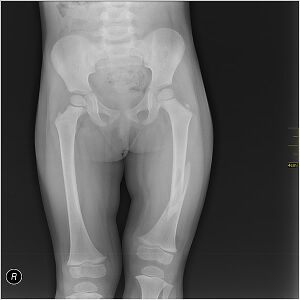Fractures of the diaphysis of the femur
From WikiLectures
Fractures of the diaphysis of the femur occur as a result of indirect (skiing) or direct violence (run over by a car wheel, car accident). Fractures in the upper third of the femur (up to 3 cm below the lesser trochanter) are referred to as subtrochanteric and are classified as fractures of the proximal femur.
AO classification (32)[edit | edit source]
- A – simple (1 – spiral, 2 – oblique, 3 – transverse)
- B – wedge-shaped (1 – spiral wedge, 2 – bending wedge, 3 – broken wedge)
- C – complex (1 – spiral, 2 – storied, 3 – coarsely fragmented)
Diagnostics[edit | edit source]
- Clinical
- thigh pain, disfigurement, pathological mobility, limited mobility, hematoma.
- Imaging methods
- X-ray in two projections (incl. hip and knee joint – storey fractures); typical is the shortening of fragment dislocations (pulling of the proximal fragment into abduction, the distal fragment medially and upwards).
Complications[edit | edit source]
- Complications of the injury:
- injury to blood vessels and soft tissues (muscles) by sharp fragments - bleeding up to 2 liters ,
- compartment syndrome .
- Treatment complications:
Therapy[edit | edit source]
First Aid[edit | edit source]
- immobilization: vacuum splint, Cramer splints, binding of both DK, formerly Dietrichs splint;
- anti-shock measures (infusions);
- X-ray before removing the first fixation.
Surgical treatment[edit | edit source]
- Osteosynthesis : must be stable to allow early mobilization (extension beyond the tuberositas tibiae is only a temporary preoperative measure),
- intramedullary nail : anterograde and closed insertion after alignment of the axis and correct length; nails tend to be secured distally and proximally, preferably undrilled;
- plate osteosynthesis: it is abandoned;
- external fixation : open fractures (Tscherne II, III), comminuted fractures, polytraumas;
- PFN (proximal femoral nail), gamma nail : in subtrochanteric fractures;
- Prévot rods (TEN – titanium elastic nails): in children.
Conservative treatment[edit | edit source]
- In children, it is possible to use a patch extension (suspension of DK vertically upwards) and after the formation of the muscle (in 4 weeks) immobilization with a plaster bandage follows.
Links[edit | edit source]
Related articles[edit | edit source]
- Fractures
- Bone fractures
Source[edit | edit source]
- PASTOR, Jan. Langenbeck's medical web page [online]. ©2006. [cit. 2011-02-02]. <http://langenbeck.webs.com/chirurgie.htm>.
References[edit | edit source]
- KOUDELA, Karel, et al. Ortopedická traumatologie. 1. edition. Karolinum, 2002. ISBN 80-246-0392-6.

